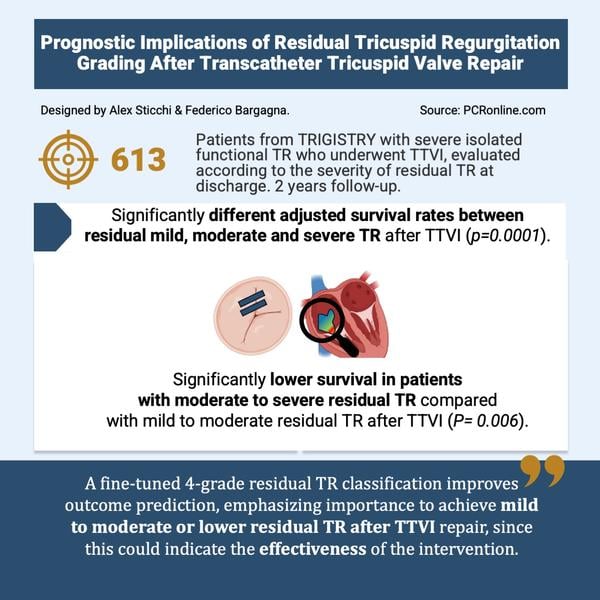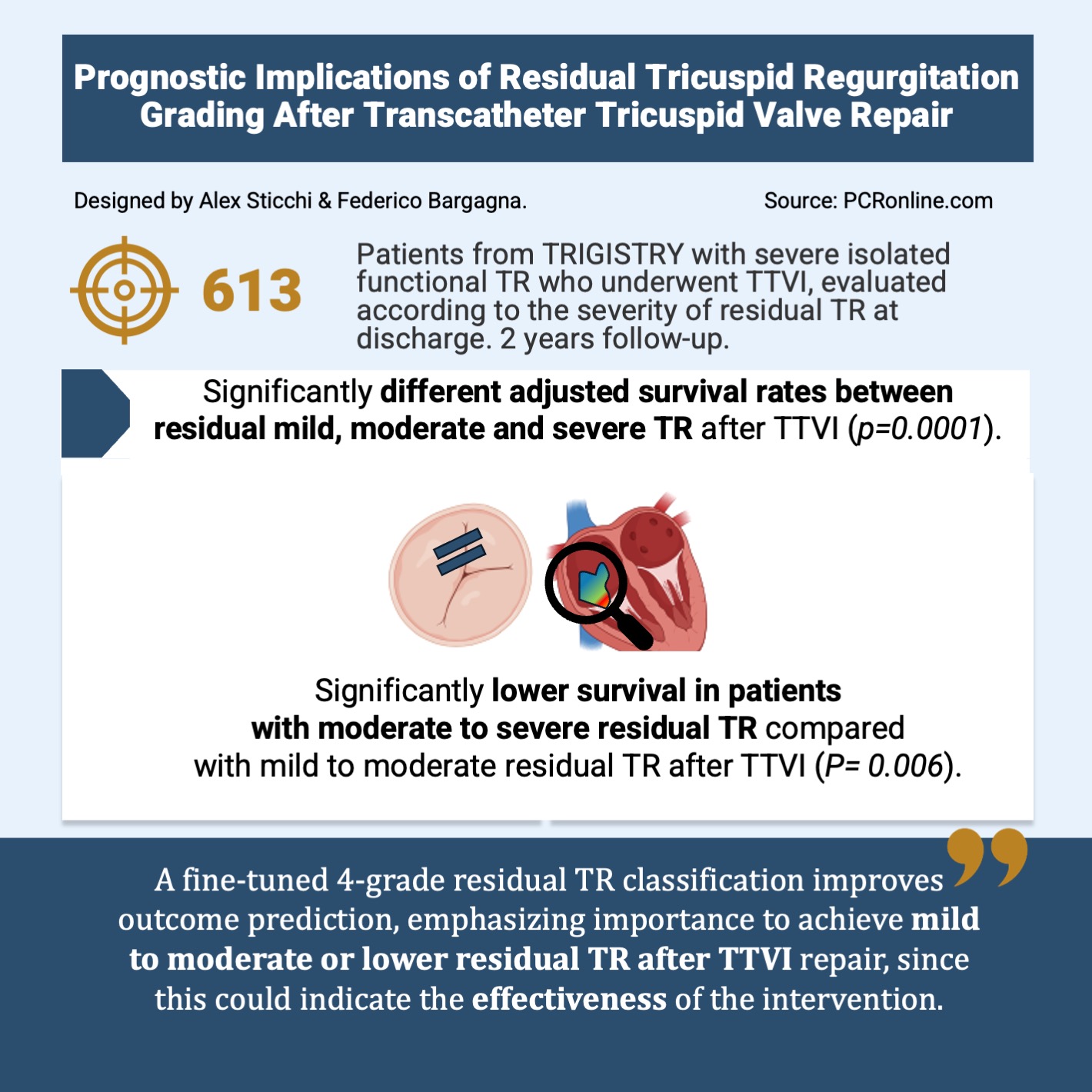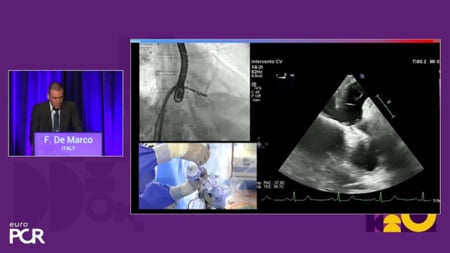Prognostic implications of residual tricuspid regurgitation grading after transcatheter tricuspid valve repair
Selected in JACC: Cardiovascular Interventions by A. Sticchi , F. Bargagna
The take-home message for clinicians is that in the treatment of tricuspid regurgitation, the most frequent valvular disease alongside aortic stenosis, redefining procedural success as a function of the residual degree of TR is crucial.

References
Authors
Julien Dreyfus, Maurizio Taramasso, Karl-Patrik Kresoja, Hazem Omran, Christos Iliadis, Giulio Russo, Marcel Weber, Luis Nombela-Franco, Rodrigo Estevez Loureiro, Jörg Hausleiter, Azeem Latib, Lukas Stolz, Fabien Praz, Stephan Windecker, Jose Luis Zamorano, Ralph Stephan von Bardeleben, Gilbert H.L. Tang, Rebecca Hahn, Edith Lubos, John Webb, Joachim Schofer, Neil Fam, Alexander Lauten, Giovanni Pedrazzini, Josep Rodés-Cabau, Mohammed Nejjari, Luigi Badano, Hannes Alessandrini, Dominique Himbert, Horst Sievert, Kerstin Piayda, Erwan Donal, Thomas Modine, Georg Nickenig, Roman Pfister, Volker Rudolph, Jordan Bernick, George A. Wells, Jeroen Bax, Philipp Lurz, Maurice Enriquez-Sarano, Francesco Maisano, David Messika-Zeitoun, and on behalf of TRIGISTRY Investigators
Reference
J Am Coll Cardiol Intv. May 16, 2024. Epublished DOI: 10.1016/j.jcin.2024.04.023
Published
May 16, 2024
Link
Read the abstractReviewers
Our Comment

Overview of this study which aimed to compare mortality rates based on the degree of RTR at discharge, using data from the TRIGISTRY Registry.
Designed by Alex Sticchi & Federico Bargagna - Source: PCRonline
Why this study? – the rationale/objective
Despite ongoing research, transcatheter tricuspid valve interventions (TTVI) have become the most commonly used treatment option in many countries, offering a less invasive alternative to surgery. The safety of TTVI is well-documented; however, significant residual tricuspid regurgitation (RTR) persists in up to one-third of patients post-treatment. This significant RTR has been associated with poor outcomes.
The objective of this study was to compare mortality rates based on the degree of RTR at discharge, using either the recommended 3-grade scheme or a 4-grade scheme that divides moderate TR into mild-to-moderate and moderate-to-severe RTR.
How was it executed? - the methodology
This study utilized data from the TRIGISTRY international retrospective multicenter registry, which included adult patients from 33 locations in 10 countries (Israel, the US, Canada, and Europe) with severe isolated functional TR on a native valve, treated with isolated TV surgery, TTVI, or medical/conservative methods.
A total of 613 patients with severe isolated functional TR who underwent TTVI were evaluated, based on the severity of RTR at discharge, and followed up for two years.
RTR grade was semiquantitatively evaluated by transthoracic echocardiography (TTE) at each center upon discharge, using a 4-grade system: none or mild, mild-to-moderate, moderate-to-severe, and severe. Results from the 4-grade scheme were compared to the 3-grade scheme, which combines mild-to-moderate and moderate-to-severe categories into a single moderate TR grade as per current guidelines.
The outcomes of interest included:
- 2-year adjusted survival rates, using the common 3-grade scheme for RTR.
- 2-year adjusted survival rates, using the new proposed 4-grade scheme for RTR.
What is the main result?
Among the 613 patients included, RTR was assessed as none-mild in 203 (33 %), moderate in 319 (52 %), and severe in 91 patients (15 %) using the 3-grade scheme.
Using the 4-grade scheme, 201 patients (33 %) had mild-to-moderate RTR, and 118 (19 %) had moderate-to-severe RTR.
Patients classified with the 3-grade scheme had significantly different 2-year adjusted survival rates (85 %, 70 %, and 44 % respectively; RMST: P = 0.0001). The adjusted survival rate was significantly different across groups, when the 319 patients with moderate RTR were split into mild-to-moderate and moderate-to-severe (85 %, 80 %, 55 %, and 44 % respectively; RMST: P = 0.001). Patients with mild-to-moderate RTR had significantly higher survival rates than those with moderate-to-severe RTR (P = 0.006). No difference was found in survival rates between patients with moderate-to-severe and severe RTR (P = 0.96) or between patients with no/mild and mild-to-moderate RTR (P = 0.67).
This study provides important additional data regarding the role of RTR in patients who underwent TTVI.
Critical reading and relevance for clinical practice
This study provides valuable insights into the role of residual tricuspid regurgitation (RTR) in patients undergoing transcatheter tricuspid valve interventions (TTVI). While TTVI has revolutionized the management of tricuspid valvular diseases, the complexity of identifying patients who benefit most from the intervention remains. Similar to the ongoing debate regarding TRI-SCORE patient selection before TTVI, this TRIGISTRY analysis underscores that moderate RTR after TTVI represents a heterogeneous group of patients. These patients range from those with clinical and prognostic characteristics akin to patients with mild or absent RTR to those with severe residual regurgitation.
Refining RTR classification using a 4-grade methodology, similar to the classifications used for mitral valve regurgitation, improves outcome prediction. By applying these study results in clinical practice, achieving a mild-to-moderate or lower RTR from TTVI and ensuring proper stratification of RTR post-intervention become critical for defining procedure success.
It is important to note that this study's results are based on data from a multicenter registry with semi-quantitative echocardiographic evaluations, which lack precise thresholds for defining RTR severity, potentially leading to over- or under-estimation. Moreover, the evaluation of RTR was performed at discharge without subsequent ultrasound follow-ups, limiting the ability to assess how RTR evolves over time, and its impact on clinical outcomes. Only 80 % of patients were treated with edge-to-edge methods, which introduces variability in treatment approaches.
New Hypotheses and Future Implications
- New Hypotheses:
- Longitudinal evaluation of RTR: future studies should hypothesize that serial echocardiographic follow-ups post-TTVI will provide a more accurate assessment of RTR progression and its long-term clinical implications. This could involve evaluating RTR at multiple time points (e.g., 3 months, 6 months, 1 year) to better understand its trajectory.
- RTR thresholds for prognosis: establishing precise echocardiographic thresholds for RTR severity could improve risk stratification and patient selection for TTVI. A hypothesis could be that setting these thresholds will enhance the predictive accuracy of outcomes.
- Impact of complete edge-to-edge repair: investigate whether patients who undergo complete edge-to-edge repair have better long-term outcomes compared to those with mixed repair methods. The hypothesis would be that uniformity in repair technique leads to more consistent and improved survival rates.
- Role of biomarkers: exploring the role of biomarkers in conjunction with RTR severity to predict patient outcomes. The hypothesis is that some biomarkers can provide additional prognostic information beyond echocardiographic findings.
- Future Implications:
- Enhanced patient selection: improved classification and understanding of RTR can lead to better patient selection for TTVI, ensuring that those who are likely to benefit most are identified accurately. This can potentially increase the success rates of TTVI procedures.
- Personalized treatment plans: with more precise RTR evaluation methods, clinicians can develop personalized treatment plans, including follow-up schedules and adjunct therapies tailored to the individual patient's RTR severity and progression.
- Refined guidelines: the findings from longitudinal studies and precise threshold settings could inform updates to clinical guidelines, providing clearer criteria for RTR management post-TTVI.
- Development of new devices: insights from RTR classifications might drive the innovation of new transcatheter devices designed to achieve more effective RTR reduction, particularly targeting moderate-to-severe cases.
- Integrated multimodal approaches: combining RTR assessments with biomarkers and other clinical data could lead to an integrated multimodal approach for managing tricuspid regurgitation, offering a more holistic view of patient health and prognosis.
Conclusion:
The take-home message for clinicians is that, in the treatment of tricuspid regurgitation, the most frequent valvular disease alongside aortic stenosis, redefining procedural success as a function of the residual degree of TR is crucial.
A more precise classification system is essential to differentiate among patients with moderate RTR—those with better prognosis comparable to mild or no RTR and those with worse outcomes similar to severe RTR. Future research should focus on refining RTR evaluation, establishing precise thresholds, and exploring the role of longitudinal follow-ups and biomarkers to improve patient outcomes and procedural success in TTVI.
Reference
Dreyfus J., Taramasso M., Kresoja K-P., et al. Prognostic Implications of Residual Tricuspid Regurgitation Grading After Transcatheter Tricuspid Valve Repair. JACC Cardiovasc Interv 2024. Doi: 10.1016/J.JCIN.2024.04.023.






No comments yet!